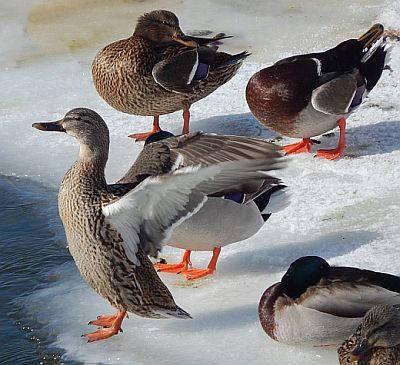by Gary Mechanic
The hero of J.D.Salinger’s “The Catcher in the Rye” Holden Caulfield famously wanted to know where the ducks go in winter, and who doesn’t? While some of us, and many of our furred and feathered neighbors leave before winter, some that stay survive by using clever tactics.
Puff Up, Shiver & Eat
Overwintering birds may grow a winter coat of feathers to help insulate them from the cold. Goldfinch feather 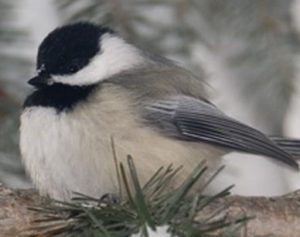 weight is about 50% higher in winter than summer. Even with feathers fluffed, insulation alone will only keep their body about 20 degrees warmer than the air temperature. At colder temperatures, except when they are flying, they shiver to stay warm more or less continuously throughout winter.
weight is about 50% higher in winter than summer. Even with feathers fluffed, insulation alone will only keep their body about 20 degrees warmer than the air temperature. At colder temperatures, except when they are flying, they shiver to stay warm more or less continuously throughout winter.
Aldo Leopold called the black-capped chickadee (Poecile atricapillus) a “bundle of large enthusiasms.” From the sound of its complex cheery songs on a cold day, its enthusiasms must include winters in the Fox Valley’s woodlands. The chickadee keeps its internal fires burning during winter days by consuming up to 20 times as much food as it does during summer.
Huddle & Cuddle
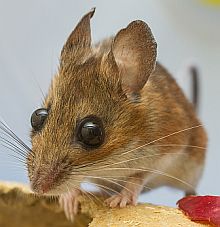 During cold winter months the normally solitary white-footed mouse (Peromyscus leucopus) gets social and huddles with others in a den to share their warmth. By cuddling up together, they reduce the area of exposed skin and radiation loss to conserve heat.
During cold winter months the normally solitary white-footed mouse (Peromyscus leucopus) gets social and huddles with others in a den to share their warmth. By cuddling up together, they reduce the area of exposed skin and radiation loss to conserve heat.
Sweet Frogs
Freezing solid would be fatal to most animals, but not the wood frog (Rana sylvatica). It regularly freezes during cold 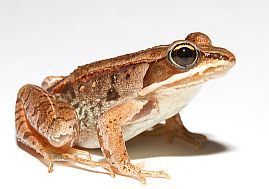 spells and thaws out in early spring to hop away to woodland ponds and puddles to mate. When ice begins to form on a wood frog’s skin, a hormonal or nervous response stimulates the release of massive amounts of ordinary blood sugar, or glucose, from the frog’s liver.
spells and thaws out in early spring to hop away to woodland ponds and puddles to mate. When ice begins to form on a wood frog’s skin, a hormonal or nervous response stimulates the release of massive amounts of ordinary blood sugar, or glucose, from the frog’s liver.
The huge amount of blood sugar released floods all vital organs in glucose within a few hours. The blood of frozen wood frogs may have a glucose level of nearly 5000 milligrams per 100 milliliters. (Humans average 50 to 100 milligrams, diabetics 300 to 400). The syrup packed frozen frog organs can survive all but the hardest freezes undamaged. When the frog thaws in the spring, this amorous amphibian awakes and hops off to a hook up at the nearest breeding pond on a sugar high!
Take the Subway

When snow blankets the ground the meadow vole (Microtus pennsylvanicus) creates an extensive network of tunnels through the snow from nest to food to seed caches. Like a igloo the loosely packed snow crystals trap air and actually insulate the tunnels and voles from the colder temperatures above.
Naked Apes & New Hides
Pop quiz! What do pigs, whales, elephants, mole rats, walruses and humans have in common? Give up?
Of the approximately 3,000  living mammal species, only these few lack full body fur. Historically humans have adapted to cold climates by appropriating the pelts of better-endowed mammals. Now, engineered fibers and fabrics outperform the best natural furs. Clothes made from high-tech fabrics are lightweight, flexible, soft and retain heat even when wet. Composite synthetics such as Gore-Tex “breathe” by releasing trapped water vapor while repelling water thereby reducing the cold clammy discomfort and evaporative heat loss of sweating.
living mammal species, only these few lack full body fur. Historically humans have adapted to cold climates by appropriating the pelts of better-endowed mammals. Now, engineered fibers and fabrics outperform the best natural furs. Clothes made from high-tech fabrics are lightweight, flexible, soft and retain heat even when wet. Composite synthetics such as Gore-Tex “breathe” by releasing trapped water vapor while repelling water thereby reducing the cold clammy discomfort and evaporative heat loss of sweating.
Finding the Ducks in Winter
It might seem to an undiscerning eye that most of the wildlife of the Fox Valley either dies or leaves before winter. But the well dressed and hardy can find surprising signs of life in the wild. Since there’s no such thing as bad weather, only bad clothing choices, here’s a guide to help the adventurous enjoy the delights of winter known only to the well prepared.
Your own adjustable microclimate
Rather than “bundling up” the way our grandparents insulated themselves, today we achieve maximum flexibility and comfort by layering clothes to remove excess moisture, retain heat, reduce radiation and insulate from conductive and convective losses. Layers allow you to build a microclimate surrounding your body and adjust the amount of protection you need throughout the day.
Start with a base layer (also known as underwear) that will transport moisture away from the skin and disperse it to the air or outer layers where it can evaporate. The best base layer materials are synthetics (polypropylene and polyester). These are light, strong, absorb very little water, and are quick to dry.
A mid-layer provides insulation and continues the transportation of moisture from the inner layer. Think flannel shirts, wool sweaters and fleece vests.
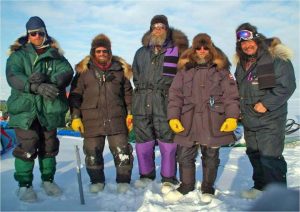
The outer layer protects you from the elements and should allow air to circulate and excess moisture to escape. In dry conditions, light insulation and a windproof outer shell may be all you need. In damp, windy, and wet weather, a waterproof shell will work but will keep excess moisture in as effectively as it keeps rain out. Gore-Tex and similar synthetic “breathable” fabrics will keep you dry and comfy.
Protect Your Pinkies & Toesies!
Extremity protection is extremely important! Mittens will keep your fingers warmer than gloves. Layering socks like clothes will help keep your feet more comfortable than a single heavy sock. And a hat that covers your head and ears will eliminate the largest source of body heat loss regardless of how much, or how little, hair you have.

